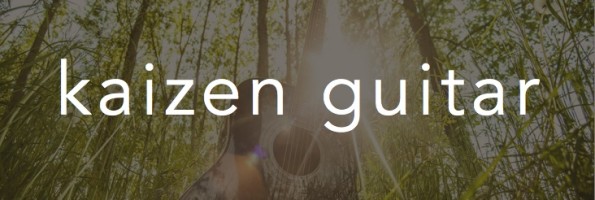Learning guitar can seem like a daunting task, and for many musicians it becomes a life-long endeavour. A new course named Kaizen Guitar from Eclectic Music promises to make it so simple you can’t fail, by breaking it down into short daily lessons.
 That’s already pretty innovative – but not only are the lessons short and daily, but they are actually provided entirely by… email! We were intrigued and so invited the course’s creator, Casey McCann, to tell us all about it.
That’s already pretty innovative – but not only are the lessons short and daily, but they are actually provided entirely by… email! We were intrigued and so invited the course’s creator, Casey McCann, to tell us all about it.
Hi Casey, and thanks for joining us at EasyEarTraining.com!
I’ll dive right in with the question that’s probably on everybody’s mind… Can you really learn guitar by email?
That’s a good question. This started as an experiment, and then within a few days, more than 60 people had signed up. So I guess we’ll find out!
I don’t think that you can become an expert guitarist via a book or email or any one source. But you can certainly get started.
””You spend a few months becoming a musician and then the rest of your life really learning to master the instrument.””
In the early stages of playing the guitar, a lot of it is about learning how music works. You spend a few months becoming a musician and then the rest of your life really learning to master the instrument. I can help with that first part in particular – teaching students how to think like musicians, and how to stay confident and continue believing in your ability to get through the challenges of doing something new.
Absolutely! Although I really want people to communicate with me to let me know which points need clarification or demonstration. The total beginner would especially benefit from submitting audio and video files to me: “Am I doing this right?”
 A student who puts in consistent effort will learn how to play simple folk tunes in standard notation, how to read tab, and how to play a number of pop songs in “sing-and-strum” style. They’ll also get a good dose of music theory. A student who is focused and seeks additional support from me might cover the equivalent of a few months worth of private lessons. Not bad for the price tag!
A student who puts in consistent effort will learn how to play simple folk tunes in standard notation, how to read tab, and how to play a number of pop songs in “sing-and-strum” style. They’ll also get a good dose of music theory. A student who is focused and seeks additional support from me might cover the equivalent of a few months worth of private lessons. Not bad for the price tag!
That’s quite a lot to achieve through an email course – impressive!
I love the idea of making the course “unquittable” by ensuring the next step is always a small one. Tell us more about what made you choose this approach.
The traditional way of learning is to take weekly lessons. I have seen some people do very well that way, but others coast and expect that just showing up is going to do the work for them. In three years, they can’t do what they could have done in one highly focused month.
So part of the benefit of this course is not so much that it’s via email, but that it’s giving you a lesson every single day for thirty days. It also helps people “fail faster” so that I can find out where the hiccups are and improve the sequencing of the material – which will help all of the folks we teach in private lessons as well.
I think it’s sustainable if the student is aware that the tiny steps forward are a critical part of the process. I’m constantly asking the course participants to review – to go back to move forward. I’m weaving in a lot of high-level practice strategies that even professionals are not aware of. Because I’m effectively teaching the student how to practice, it paves the way for them to continue on their own effectively.

The course uses movable do solfege. I’m heavily influenced by Kodály in the order in which I introduce the notes. To my knowledge, there is no guitar method that introduces note-reading or ear training in this sequence.
There are three ways to learn a note:
- By its name and physical location on the staff and the instrument (the old school “name the notes as you play” approach)
- By its relationship to other notes (reading intervallically)
- By the note’s relationship to the key.
My reasoning in teaching movable do solfege right from the start is that this third way of learning to read music is superior to the first two. The solfege is easier to sing, and students understand melodic patterns quickly.
In the short term and the long term, students who use movable do solfege are learning how notes function within a scale, and that each tone of the scale has a distinctive “color” which is consistent from key to key. They can then play by ear right from the beginning.
There aren’t many guitar courses that promise that! Excellent.
You also teach a “Play anything” live workshop which helps musicians break into playing by ear. Could you tell us more about how that works? Will the Kaizen Guitar course help students move towards this too?
The Play Anything workshop is a sneaky way of teaching music theory. I’ve worked with students who have degrees in music who say that the workshop has helped them understand all the stuff they were supposed to have gotten in college. The workshop extends the idea that each tone of the scale has a color, and introduces harmony also in terms of color. In other words, each chord of the scale has a color that you can come to recognize through studying and playing a careful sequence of pop songs – everything from the Rolling Stones to Mazzy Star to One Republic.
I do touch on this stuff in the Kaizen Guitar course, because to me it makes more sense to think, “Oh, we’ve got a one-four-five progression here” as opposed to “This is G, C, and D.” Thinking of the names of the chords teaches you one song, but thinking about the numbers of the chords (their relationship to the key) teaches you hundreds!
You can learn more about the Kaizen Guitar course and sign up here. Note that they are currently accepting new students for free until March 1st, so act fast if you’re interested! After that please see this page for more information.







